Cyclophilin anaCyp40 regulates photosystem assembly and phycobilisome association in a cyanobacterium
- PMID: 35354803
- PMCID: PMC8967839
- DOI: 10.1038/s41467-022-29211-w
Cyclophilin anaCyp40 regulates photosystem assembly and phycobilisome association in a cyanobacterium
Abstract
Cyclophilins, or immunophilins, are proteins found in many organisms including bacteria, plants and humans. Most of them display peptidyl-prolyl cis-trans isomerase activity, and play roles as chaperones or in signal transduction. Here, we show that cyclophilin anaCyp40 from the cyanobacterium Anabaena sp. PCC 7120 is enzymatically active, and seems to be involved in general stress responses and in assembly of photosynthetic complexes. The protein is associated with the thylakoid membrane and interacts with phycobilisome and photosystem components. Knockdown of anacyp40 leads to growth defects under high-salt and high-light conditions, and reduced energy transfer from phycobilisomes to photosystems. Elucidation of the anaCyp40 crystal structure at 1.2-Å resolution reveals an N-terminal helical domain with similarity to PsbQ components of plant photosystem II, and a C-terminal cyclophilin domain with a substrate-binding site. The anaCyp40 structure is distinct from that of other multi-domain cyclophilins (such as Arabidopsis thaliana Cyp38), and presents features that are absent in single-domain cyclophilins.
© 2022. The Author(s).
Conflict of interest statement
The authors declare no competing interests.
Figures
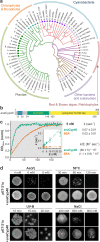
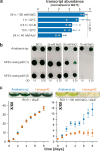
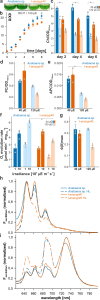
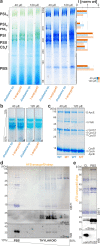



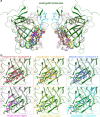

Similar articles
-
Crystal structure of Arabidopsis cyclophilin38 reveals a previously uncharacterized immunophilin fold and a possible autoinhibitory mechanism.Plant Cell. 2012 Jun;24(6):2666-74. doi: 10.1105/tpc.111.093781. Epub 2012 Jun 15. Plant Cell. 2012. PMID: 22706283 Free PMC article.
-
Complex lumenal immunophilin AtCYP38 influences thylakoid remodelling in Arabidopsis thaliana.J Plant Physiol. 2019 Dec;243:153048. doi: 10.1016/j.jplph.2019.153048. Epub 2019 Oct 1. J Plant Physiol. 2019. PMID: 31639536
-
Characterization of Arabidopsis thaliana thylakoid lumen 7.6 protein functions in photosystem II assembly.Commun Biol. 2025 Mar 25;8(1):490. doi: 10.1038/s42003-025-07907-1. Commun Biol. 2025. PMID: 40133586 Free PMC article.
-
The cyclophilins.Genome Biol. 2005;6(7):226. doi: 10.1186/gb-2005-6-7-226. Epub 2005 Jun 27. Genome Biol. 2005. PMID: 15998457 Free PMC article. Review.
-
Regulatory factors for the assembly of thylakoid membrane protein complexes.Philos Trans R Soc Lond B Biol Sci. 2012 Dec 19;367(1608):3420-9. doi: 10.1098/rstb.2012.0065. Philos Trans R Soc Lond B Biol Sci. 2012. PMID: 23148269 Free PMC article. Review.
Cited by
-
Nitrogen-regulated antisense transcription in the adaptation to nitrogen deficiency in Nostoc sp. PCC 7120.PNAS Nexus. 2023 Jun 2;2(6):pgad187. doi: 10.1093/pnasnexus/pgad187. eCollection 2023 Jun. PNAS Nexus. 2023. PMID: 37361547 Free PMC article.
-
Pyridoxine dehydrogenase SePdx regulates photosynthesis via an association with the phycobilisome in a cyanobacterium.Plant J. 2025 Mar;121(6):e70055. doi: 10.1111/tpj.70055. Plant J. 2025. PMID: 40120634 Free PMC article.
-
Genome-wide characterization of FK506-binding proteins, parvulins and phospho-tyrosyl phosphatase activators in wheat and their regulation by heat stress.Front Plant Sci. 2022 Dec 15;13:1053524. doi: 10.3389/fpls.2022.1053524. eCollection 2022. Front Plant Sci. 2022. PMID: 36589073 Free PMC article.
References
-
- Andrzej G. Peptidylprolyl cis/trans isomerases (immunophilins): biological diversity—targets—functions. Curr. Top. Med. Chem. 2003;3:1315–1347. - PubMed
-
- Schiene-Fischer C. Multidomain peptidyl prolyl cis/trans isomerases. Biochim. Biophys. Acta. 2015;1850:2005–2016. - PubMed
-
- Romano P, Gray J, Horton P, Luan S. Plant immunophilins: functional versatility beyond protein maturation. N. Phytol. 2005;166:753–769. - PubMed
-
- Schreiber SL. Chemistry and biology of the immunophilins and their immunosuppressive ligands. Science. 1991;251:283–287. - PubMed
-
- Stewart DE, Sarkar A, Wampler JE. Occurrence and role of cis peptide bonds in protein structures. J. Mol. Biol. 1990;214:253–260. - PubMed
Publication types
MeSH terms
Substances
Grants and funding
LinkOut - more resources
Full Text Sources

